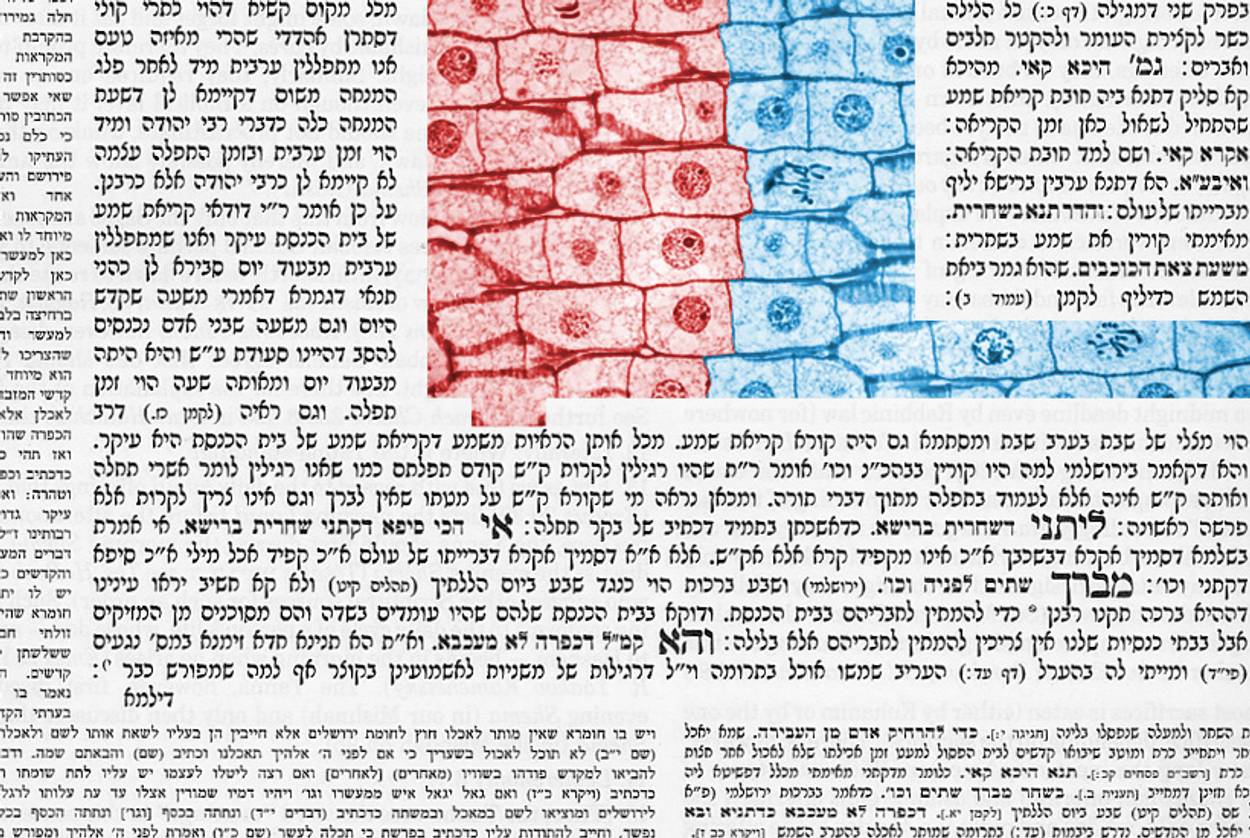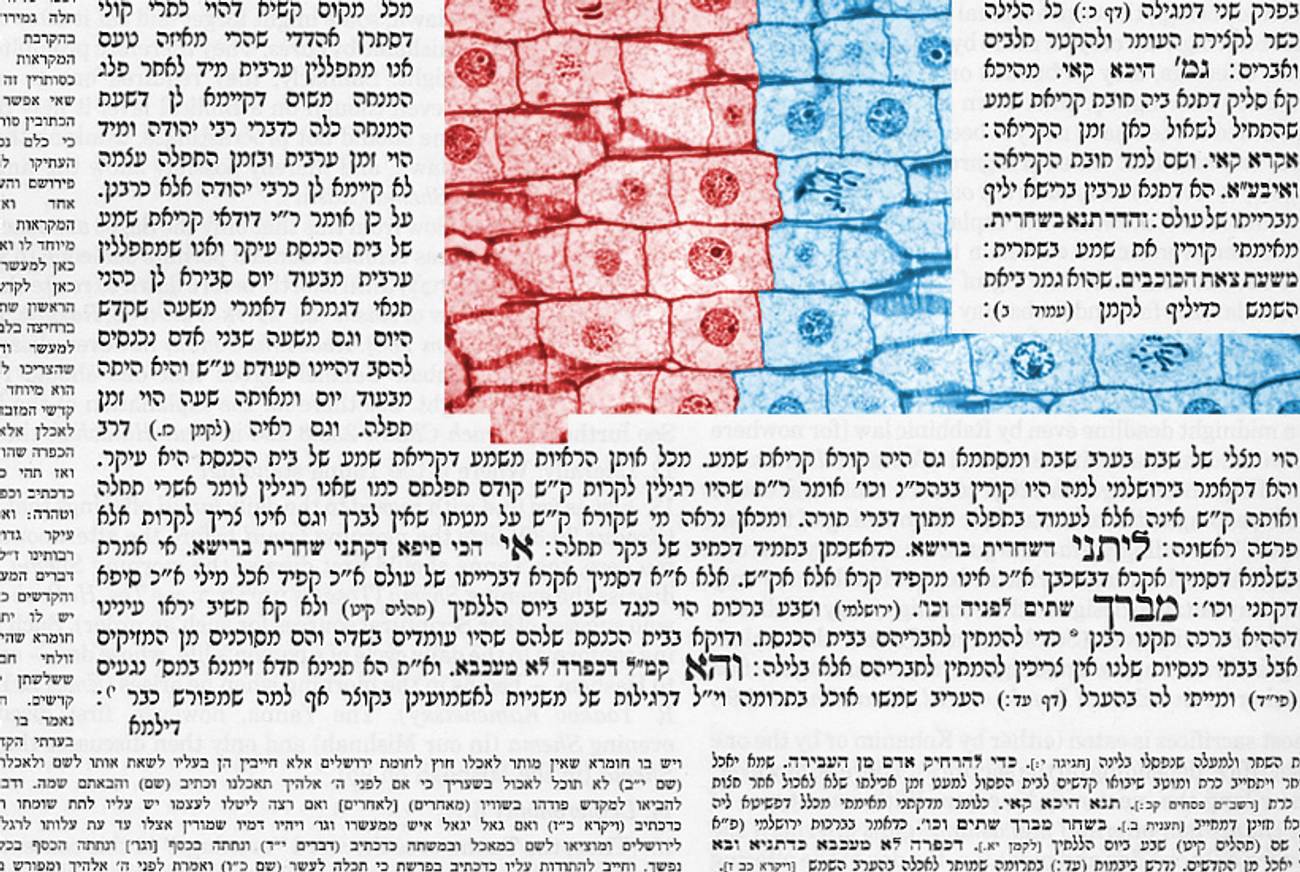Appreciating the Talmud’s Sublime Devotion to Torah for Its Own Sake
Daf Yomi: For the rabbis, trivial—even outdated or immaterial—problems can provide the best thought experiments




Literary critic Adam Kirsch is reading a page of Talmud a day, along with Jews around the world.
Science teaches us to see the world through inhuman eyes. From the strictly materialist point of view—the view you might get through an electron microscope—no particular place or substance differs essentially from any other. No matter where you look, you see atoms in motion. In the modern world, we have learned this way of seeing so successfully that we even call it natural.
But in historical or psychological terms, it is highly unnatural to look at the world and see uniform matter. On the contrary, the most basic human instinct is to differentiate, to separate, between places and times. One day is a workday, another a holiday; one mountain is just dirt and rocks, while another is the home of the gods; one man is an untouchable, another a high priest. For nearly all of human history, people have viewed the world in this symbolic, value-laden fashion.
Judaism, of course, offers plenty of examples of this kind of symbolic organization of the world. Six days a week you may work, but on the seventh you must rest. Jerusalem is holy, while Babylon is profane. Some animals are kosher, others trayf. It is tempting to dismiss such distinctions by saying that they don’t “really” exist; but they do exist, in the mind of the person who believes in them. (For the Jew who keeps kosher, it is a sin to eat pork, so much so that eating it might actually produce nausea.) Other religions have their own versions of these taboos—Hindus don’t eat beef; Muslims think Mecca is the holiest city—but one definition of a religion is that it structures the world for its believers, imparting values where there would otherwise merely be things.
The last two weeks’ Daf Yomi readings featured a spectacular example of this kind of religious interpretation—or, if you prefer, distortion—of reality. Starting with Pesachim 14a and continuing until the end of Chapter 1 seven pages later, the Talmud was taken up with a long digression known as the sugya of Rabbi Hanina Segan ha-Kohanim. This discussion is devoted to working out, in minute detail, the concept of tumah—the state of ritual contamination that renders a priest unfit for service in the temple, or food unfit for use as a sacrifice. Something that contracts tumah is known as tamei, unclean or impure; the opposite of tamei is tahor. These concepts have danced in and out of the Talmudic discussion ever since I began Daf Yomi, but now they take center stage. According to the Schottenstein Edition’s notes, the sugya of Rabbi Hanina is one of “the primary Talmudic sources for many of the laws” of tumah.
Those same notes define tumah as “a physically indiscernible ritual contamination that can affect persons, articles, foods, and beverages.” Tumah, one might say, is the ultimate example of the way Judaism shapes the world for the believing Jew. You can’t see, touch, or taste tumah; no microscope could ever locate it. Yet for the rabbis of the Talmud it is a crucial property of people and things—so crucial that they devote a great deal of intellectual energy to explaining just how it works. (I did my best to follow the discussion, though I’m sure many of the nuances have escaped me.)
The topic emerges, on Pesachim 14a, out of the ongoing discussion about how to dispose of chametz before Passover. In the Land of Israel, it was required since biblical times for every Jewish farmer to separate a portion of his produce to give to the kohanim, the priests. This offering was known as terumah, and it had to remain ritually pure for the priests to be able to eat it. Now, the rabbis wonder, say you had two portions of terumah grain, one tahor and good for the priests to eat, the other tamei and forbidden to eat. At midday on the 14th of Nissan, before Passover begins, it is required to destroy all the chametz in one’s possession. The question is: Can we burn the tahor chametz and the tamei chametz together, in the same fire? Is this forbidden, because by burning them together, the tahor would be contaminated by the tamei? Or does this not matter, because either way the grain is going to be destroyed, and so it won’t be eaten by the priests?
This is a seemingly minor question. The problem cannot have arisen all that often, and if there were any doubt, it wouldn’t have been hard to simply light two different fires. (Indeed, the rabbis go on to observe that this would be only a minimal hardship, costing only the price of a few sticks of wood.) We have often seen before, however, that trivial problems can provide the best thought experiments for the rabbis. And so it is here. From the initial question about burning chametz, the Talmud evolves a whole classification of five levels of tumah and various rules about what sorts of substances can contaminate one another.
Just to get the flavor of this long and involved discussion, let’s look at how the argument begins. To answer the question about tahor and tamei terumah, the Tannaim—the rabbis of the Mishnah—use one of their favorite techniques: drawing analogies from other areas of Jewish law. Rabbi Hanina Segan ha-Kohanim—the second two words are his title, indicating that he was deputy high priest—starts off by talking about sacrificial meat. “In all the days of the kohanim,” he says, “never did they refrain from burning meat that had been contaminated by a derived tumah together with meat that had been contaminated by an av hatumah, although by doing so they added tumah to its previous tumah.”
To understand what this means, it’s necessary to go into the question of degrees of tumah. An av hatumah—literally, a “father of tumah”—is anything that can impart contamination to other things and people: Examples include a corpse, an improperly slaughtered animal, a man who has had a seminal emission, and a menstruating woman. Any person or utensil that comes into contact with an av hatumah becomes tamei in the first degree—in Hebrew, rishon.Such a contaminated person or utensil cannot itself transmit tumah to other people or utensils. However, a rishon can transmit tumah to foods and beverages, because these are capable of contracting three further degrees of tumah—second (sheni), third (shelishi), and fourth (revi’i)—depending on their own degree of holiness. Thus, if I have things right, if a man touches a corpse and then touches a piece of meat, the meat is a sheni; if that meat then touches some terumah, the terumah becomes a shelishi.
Now back to Hanina’s point. He is talking about a situation in which one piece of meat was contaminated by an av hatumah—say, by touching a corpse—and a second piece of meat was contaminated in the second degree—say, by being cooked in an oven that had been used by a menstruating woman. The first piece of meat was rishon, the second sheni. Burning them together would presumably transfer the rishon’s degree of tumah to the sheni, thus making it more contaminated. Yet the priests didn’t seem to be bothered by this, since both pieces of meat were going to be destroyed anyway. Does this offer a precedent that can be used to decide the question of the terumah on Passover?
In the Gemara, the Amoraim debate this question fiercely and at length. Can a food, they ask, convey tumah to another food? If it can’t do so under biblical law, can it do so under rabbinic law? What about beverages and liquids—can they convey tumah to one another? Are you allowed to deliberately render a portion of wine tamei in order to preserve a much greater quantity that is tahor? More fundamentally, is Hanina’s example, in which two tamei things are burned together, really analogous to the Passover example, in which one thing is tamei and the other tahor?
Just as important as the answers to all these questions is the source of those answers. Much of these seven pages is devoted to figuring out which Tanna held which opinion and which later rabbi agreed with which earlier one. As always, I find this one of the hardest strands of the Talmud to keep straight. You would need to draw up a table of the kind used to solve logic problems to remember whether Elazar agreed with Yehoshua and which one Yose was challenging. Yet getting such matters right was essential to the rabbis, since they were transmitting a long oral tradition and couldn’t afford to lose track of the genealogy of each legal opinion.
The detail and precision of the arguments are even more impressive when you remember that the whole subject was doubly abstract. Not only was tumah an invisible, incorporeal status, a pure concept; it was a concept that applied only in the Temple, where it affected the status of the priests and the sacrifices. But by the time the Talmud was edited, around 500 C.E., the Temple had been gone for 400 years—as much time as separates us today from Shakespeare. For the Amoraim, there were no sacrifices to perform, and in Babylonia, where they lived, there was no requirement to tithe crops at all.
Yet the rabbis devoted as much intellectual force to getting tumah right as if it were still a matter of life and death, and they write about the sacrifices as if they might be called on to perform one tomorrow. The law, for them, existed in a virtual realm, immune from time and change. This devotion to Torah for its own sake is, for me, one of the most foreign things about the Talmud—and one of the most sublime.
***
Like this article? Sign up for our Daily Digest to get Tablet Magazine’s new content in your inbox each morning.
Adam Kirsch is a poet and literary critic, whose books include The People and the Books: 18 Classics of Jewish Literature.
Adam Kirsch is a poet and literary critic, whose books include The People and the Books: 18 Classics of Jewish Literature.